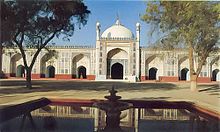Shahi Eid Gah Mosque
| Shahi Eid Gah Mosque | |
|---|---|
شاہی عید گاہ مسجد | |
 | |
| Religion | |
| Affiliation | Islam |
| Ecclesiastical or organizational status | Mosque |
| Location | |
| Location | Multan, Punjab, Pakistan |
Shown within Punjab, Pakistan | |
| Geographic coordinates | 30°12′39″N 71°28′44″E / 30.2107936°N 71.4789388°E |
| Architecture | |
| Type | Mosque |
| Style | Indo-Islamic/Mughal |
| Completed | 1735 |
| Dome(s) | 7 |
The Shahi Eid Gah (Urdu: شاہی عید گاہ مسجد) is an early 18th-century mosque located in Multan, southern Punjab.[1]
Location
[edit]Located on the main Multan-Lahore highway in the Northeast of the oldest part of the city. The mosque is adjacent to the 20th century Sufi shrine of Ahmad Saeed Kazmi.
History
[edit]Founding
[edit]The mosque was built in 1735 CE during the reign of Mughal Emperor Muhammad Shah.[2] The mosque was funded by Nawab Abdul Samad Khan, who was the Mughal governor of Multan.[citation needed]
British
[edit]
The mosque was used as a court during the early British period in Multan.[3] It was restored and returned to its original purpose in 1891 at the insistence of Deputy Commissioner H.C. Cookson.[3]
Modern
[edit]After the independence of Pakistan, the courtyard was expanded to accommodate more worshippers.[citation needed]
Architecture
[edit]The mosque is spacious, with a vast courtyard and a prayer chamber measuring 250 feet by 54 feet, and features seven domes.[citation needed]
The mosque's exterior is embellished with glazed blue Multan-style tiles, while the interior is ornamented with intricate mosaics.[citation needed]
See also
[edit]References
[edit]- ^ "Eidgah Mosque: Restored spirituality". 13 August 2017.
- ^ Quarterly Journal of the Pakistan Historical Society, Volume 47. Pakistan Historical Society. 1999.
- ^ a b Chaudhry, Nazir Ahmad (2002). Multan Glimpses: With an Account of Siege and Surrender. Sang-e-Meel Publications. ISBN 9789693513516.


